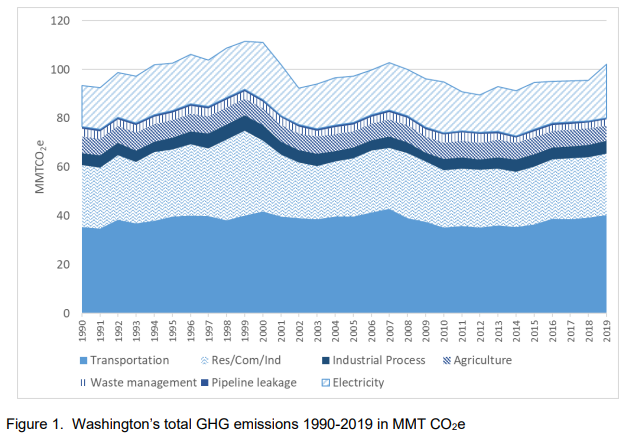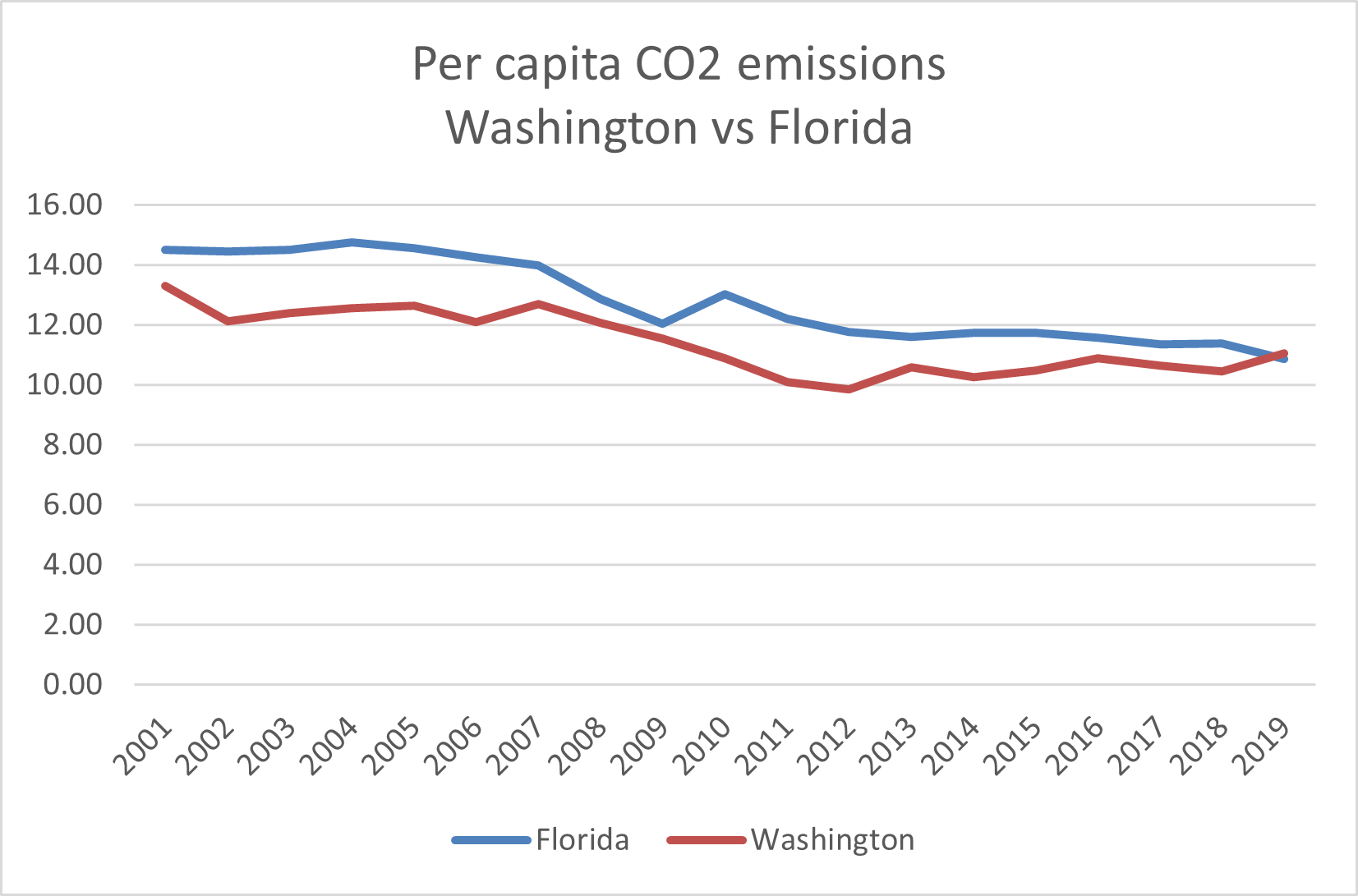Washington state’s CO2 emissions increased again, and the failure of state policy to reduce emissions – despite spending huge sums of taxpayer dollars – is instructive and shows how a lack of accountability for environmental results makes it unlikely that our policies will succeed.
Rather than doubling-down on the failed top-down regulatory approach, legislators should empower innovators and citizens to find ways to become more energy efficient and reduce emissions.
 The Washington State Department of Ecology released statewide CO2 emissions for 2019, showing an increase of about seven percent from 2018. Since 2012, Washington’s CO2 emissions have increased almost every year and total emissions increased about ten percent to 102.1 million metric tons (MMT).
The Washington State Department of Ecology released statewide CO2 emissions for 2019, showing an increase of about seven percent from 2018. Since 2012, Washington’s CO2 emissions have increased almost every year and total emissions increased about ten percent to 102.1 million metric tons (MMT).
Washington’s emissions are now nine percent higher than 1990 levels. According to state law, emissions must fall to just 51.4 MMT by 2030, 50 percent below the 2019 emissions levels.
The increases are contrary to the repeated predictions of Department of Ecology staff and the governor who claim that our climate policies are working and that state emissions are “turning the corner.”
In a blog addressing the latest increase in emissions, Ecology staff claimed “Going all the way back to 2006, our state has launched a range of initiatives designed to bring down carbon pollution and transition from polluting sources of energy. Long story short, a review of these policies shows that they are working as intended.” That claim is not credible given the consistent claims by Ecology staff that emissions would be declining. Instead, they have consistently increased.
For example, two years ago, when the emissions data for 2018 were released, the Department of Ecology claimed, “Greenhouse gas emissions are up, but help is on the way,” promising “Yes, our carbon reduction policies are, in fact, working.”
Similarly, in 2017 when emissions were flat compared to 2016, former Ecology Director Maia Bellon claimed, “What we’re seeing is that our state’s carbon reduction strategies are beginning to pay off.”
And in 2015, Ecology staff predicted that Washington’s CO2 emissions would fall consistently, reaching 93.4 MMT in 2019. The new data show their predictions were off by nine percent.
Year after year, the predictions have been wrong. These consistent failures, however, have not resulted in a reconsideration of the expertise of Ecology staff or of the policies they advocate.
Emissions increased in virtually all sectors
While maintaining that their climate policies are working, Ecology staff blamed a poor water year for the 2019 increase in emissions. “The rise stems from increased electricity demand combined with an unusually poor year for hydropower in Washington,” a press release from Ecology claimed. “Less water behind the state’s dams in 2019 pushed utilities to use fossil fuel generation to make up the difference.”
Snowpack was lower than usual in 2019, ending up at 84.5 percent of normal for the snow year. But blaming slightly below normal snowpack for the increase shows how ineffective our climate policies have been. Washington’s climate policy has so little impact, it can be overwhelmed by small changes in snowpack.
Additionally, while blaming snowpack for the increase in 2019, Ecology staff did not cite above-normal snowpack for limiting electricity-related CO2 emissions in 2017, when snowpack was 115 percent of normal, and 2018, when it was 110 percent of normal. In both of those years, the Department claimed it was their policies – not good snowpack – that kept emissions in check. Snowpack is only cited when it is politically useful.
There is an additional problem with pointing to low snowpack as the culprit for increasing emissions. The emissions inventory confirms that electricity-related CO2 emissions did increase. But so did emissions in virtually every other category, including buildings, transportation, and industrial processes. The only category that saw a reduction in total emissions was agriculture, which fell by nearly nine percent.
Even if electricity-related CO2 emissions had remained flat, the state’s total emissions would still have increased. Lower-than-normal snowpack contributed to the increase but wasn’t the cause.
Washington lags behind nation in CO2 reduction
Despite consistently increasing emissions and a failure to meet their own projections, Department of Ecology staff assure us that the state’s climate policies are working. Joel Creswell, the climate policy section manager at Ecology boasted that “It’s remarkable how successful Washington has been in growing our economy and decarbonizing at the same time.”
For that claim, he cites Washington’s reduction in per capita CO2 emissions. The agency’s press release explained, “per capita emissions have decreased over the past 20 years, and that fewer emissions are required for every dollar generated by Washington’s economy.”
 Data from the U.S. Energy Information Administration confirm that Washington’s per capita CO2 emissions have declined 17 percent in the last 20 years. The U.S. as a whole, however, reduced per capita CO2 emissions by 22 percent. Washington is actually decarbonizing more slowly than the rest of the country.
Data from the U.S. Energy Information Administration confirm that Washington’s per capita CO2 emissions have declined 17 percent in the last 20 years. The U.S. as a whole, however, reduced per capita CO2 emissions by 22 percent. Washington is actually decarbonizing more slowly than the rest of the country.
One notable example is Florida. Over the last 20 years, Florida’s per capita CO2 emissions have declined by more than 25 percent. For 2019, per capita emissions in Florida are actually lower than Washington’s.
Despite the talk about Washington’s leadership on climate policy, Florida has been more successful at reducing per capita emissions.
Taxpayers will pay the price for this failure
Governor Inslee continues to claim “We're on track so far” to meet our CO2 emissions goals ,but says “we need to do some additional things.” Of course, Washington is not on track and the past policies have failed to deliver the promised results. That past failure now means taxpayers must pay for “additional things,” and for the increased rate of reduction required by past high emissions.
A new CO2 cap took effect on January 1 which requires the state to meet the 2030 emissions goal set in law. Due to the state’s very high emissions, the rate of decline required to meet the target will be more strict, increasing the cost of meeting that goal.
Rather than continuing to follow the path of failed policy, legislators and agency staff should stop pretending they can effectively reduce state CO2 emissions and empower citizens and innovators to reduce emissions more sustainably and effectively.





